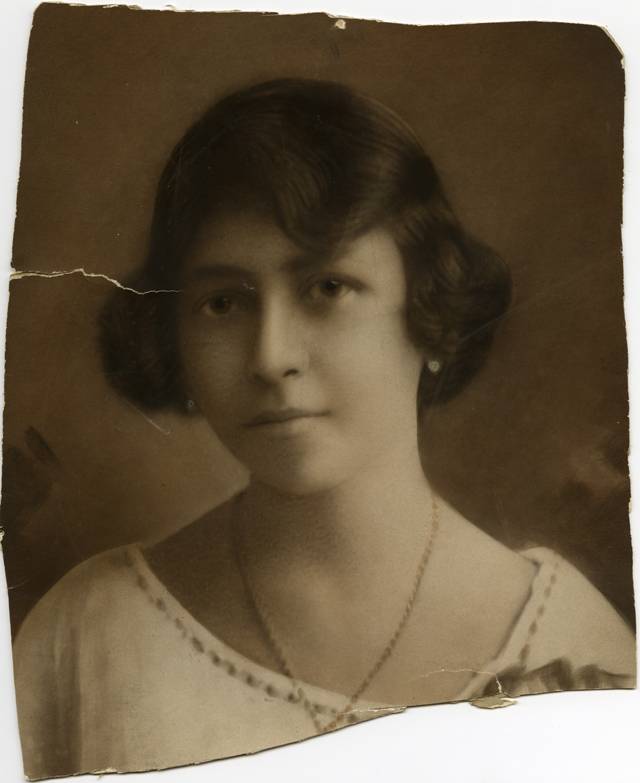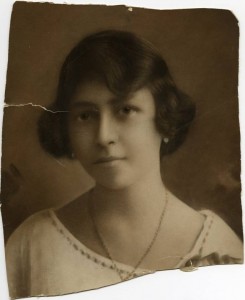Clotilde Arias honored for Spanish version of Star-Spangled Banner

 By Susana G. Baumann, Voxxi
By Susana G. Baumann, Voxxi
Surprised?
A little known and never sung version, this post World War II translation is part of a new biographical exhibition, “Not Lost in Translation: The Life of Clotilde Arias,” opening at the Smithsonian National Museum of American History last week, and part of the museum’s permanent collection.
The Clotilde Arias exhibit is one of a series of performances, lectures, exhibitions, family activities and tours at various museums around the institution celebrating Hispanic Heritage Month.
Coral Cantigas, a chamber chorus specializing in the music of Latin America, brought to life Clotilde Arias’s Spanish version of “The Star-Spangled Banner” during an event that also included her best-known composition, “Huiracocha.” The Cantigas was commissioned by the museum to record these two songs for the related exhibition.

Clotilde Arias sitting at the piano in her Brooklyn, NY apartment, circa 1925. (Courtesy of the Smithsonian’s National Museum of American History)
Clotilde Arias’s “El Pendón Estrellado” (The Star-Spangled Banner) was commissioned under President Franklin D. Roosevelt’s “Good Neighbor Policy” to secure allies in Latin America during the global conflict.
Marvette Perez, curator of Latino History at the museum, believes the purpose of the commission was a way to assimilate immigrants into the United States as well as to share the nation’s values and patriotism with Central and South American nations.
“Arias too believed that people’s aspirations could be promoted and achieved through music,” Perez said. “Her translation is extremely faithful to the original, which is a difficult accomplishment as Spanish requires about twice as many words than English to convey the same message.”
As part of diplomacy that included cultural exchanges of artists, musicians, poets and writers, the Music Educators National Conference created a competition to write an original Spanish translation of the national anthem.
Clotilde Arias: Behind the Spanish version of Star-Spangled Banner
Clotilde Arias, a Peruvian immigrant who came to the United States in 1923, won the competition and a contract paying her $150, which specified the translation had to be as close as possible to the English song in rhyme, verse and meter.

Group portrait of colleagues at McMillan Publishing, including on far left, Author James Michner and on far right, Composer Maria Grever of “What a Difference a Day Makes.”
She had arrived in New York City to study music but abandoned her studies to support her family. Clotilde Arias led an extraordinary life, working in professions that were not easily accessible to women. In the era of the creative expansion of the Harlem Renaissance, she flourished as a composer, musician, journalist, copywriter, activist and educator, as well as a mother. Arias became a naturalized U.S. citizen in 1942.
She is most known for her composition, “Huiracocha,” which pays tribute to an Incan deity in a style of music indigenous to the Andes and Peru, and talks about the struggle of a race.

Composer Clotilde Arias showcasing her work at the piano with Argentine Composer and Conductor Terrig Tucci, 1942. (Courtesy of the Smithsonian’s National Museum of American History)
Arias became the head of the Art and Music Committee of the United Women of the Americas. She believed that knowledge of other cultures and traditions could bring understanding and unity among peoples.
Through the lens of her possessions and papers—photographs, personal and professional documents, journals and objects—the exhibition looks at the life of Clotilde Arias, the first woman to translate the national anthem into its official Spanish version in 1945.
Clotilde Arias’ original music manuscript for “The Star-Spangled Banner” in Spanish, “El Pendón Estrellado,” is a featured object in the exhibition. “The Star-Spangled Banner” had been translated into several languages but Arias’ 1945 version still stands as the only faithful translation of the national anthem able to be performed in Spanish to the tune of the original composition.
Clotilde Arias “El Pendón Estrellado” (The Star-Spangled Banner)

Clotilde Arias’ original music manuscript for “The Star-Spangled Banner” in Spanish, “El Pendón Estrellado” which was a faithful translation that could be sung as required by her contract with the U.S. Department of State. (Courtesy of the Smithsonian’s National Museum of American History)

(first page) State Department contract outlining the official request for a Spanish translation of the national anthem, “The Star-Spangled Banner,” that could be sung to the original music, 1945. Clotilde Arias’s “El Pendón Estrellado” was commissioned under President Franklin D. Roosevelt’s “Good Neighbor Policy.” (Courtesy National Museum of American History)

(second page) State Department contract outlining the official request for a Spanish translation of the national anthem, “The Star-Spangled Banner,” that could be sung to the original music, 1945. Clotilde Arias’s “El Pendón Estrellado” was commissioned under President Franklin D. Roosevelt’s “Good Neighbor Policy.” (Courtesy National Museum of American History)

Clotilde Arias’ IBM professional headshot. (Courtesy of the Smithsonian’s National Museum of American History)
This article was first published in Voxxi.
Susana G Baumann is the Director of LCSWorldwide. A multicultural expert, a business blogger & a published author. Booklist Online calls her book “Hola, amigos! A Plan for Latino Outreach” a “centerpiece of the publisher’s Latinos and Libraries series.”
[Photos and documents courtesy Smithsonian’s National Museum of American History]
